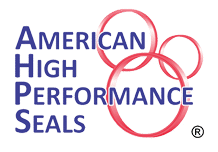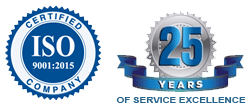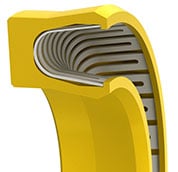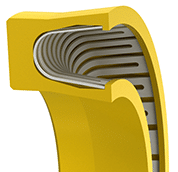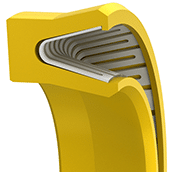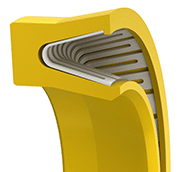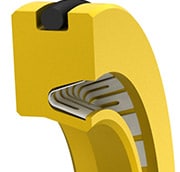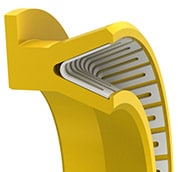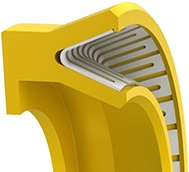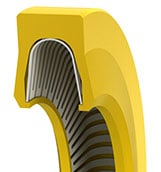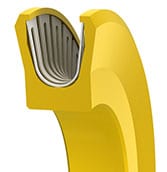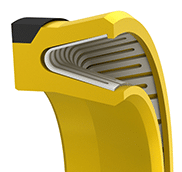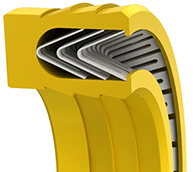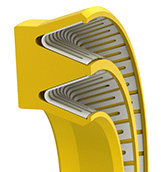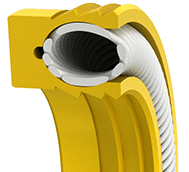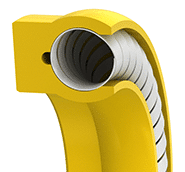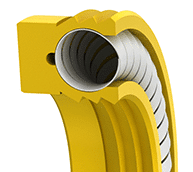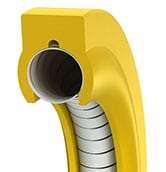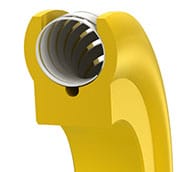Spring-energized PTFE - PTFE Seals

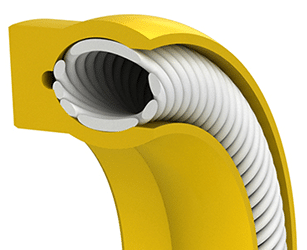
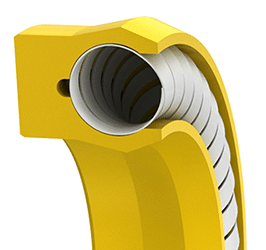
Spring-energized PTFE seals are typically used in areas where elastomeric seals cannot meet the frictional, temperature, pressure, or chemical-resistance requirements of the application.
AHPSeals designs and manufactures PTFE and other high-performance polymer composite spring-energized seals in inch and metric sizes for linear or reciprocating rod and piston sealing applications, for rotating shafts and bores, and for static and axial face sealing applications of low and high viscous liquids and gaseous media under low and high pressure up to 10,000psi (690bar), including vacuum sealing.
This section covers primarily spring-energized seals for linear, reciprocating and static sealing applications. For more information on spring-energized rotary seals, please visit our rotary seals page.
Spring-energized seals made of PTFE are characterized by:
- Low and high temperature resistance (-328°F to 500°F, -200°C to 260°C)
- FDA compliant compounds and designs available
- Exceptional resistance to chemicals and corrosion
- Provide the lowest coefficient of friction of all sealing materials
- Unlubricated dry-running capabilities
- Pressure for standard designs up to 3,000psi (210 bar)
- High pressure special seal designs up to 20,000psi (1380bar)*
Seal Design Consideration:
• Spring Type and load characteristics…
• Spring Type and load characteristics
Spring Type
Compared to elastomeric sealing materials (Nitrile, Viton® Rubber or Polyurethane), PTFE is a plastic material and offers little or no memory after being compressed; therefore, most seals made out of PTFE or other thermoplastic materials need to incorporate an energizing element, most commonly made of a metal spring. Some of our standard springs are made of 300 series stainless steel material, but other material options like Elgiloy®, Hastelloy®, and Inconel® are available.
There are fundamentally three spring types available:
- VS-type or V-spring
- SC-type or slanted-coil spring
- HS-type or helical spring
Each spring proves specific performance characteristics differentiating in spring load and spring deflection range.
Two things to be considered when selecting a spring:
– Spring load
The spring load affects the sealing ability; the higher load provides a tighter seal with higher friction and wear.
– Deflection range
A larger spring deflection range affects the seal’s ability to compensate better for normal seal wear, shaft/bore misalignment and shaft run out. The spring and, therefore, the seal deflection range increases with a larger spring cross-section.
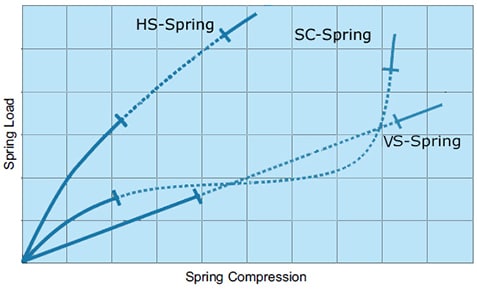
Spring Characteristics
VS-Spring:

Is made from flat stock stainless metal strip with a meander pattern and formed into a rounded V-shape. The standard material is SS301. The geometry of the V-Spring provides great flexibility with a moderate and progressive spring load versus deflection right at the edge of the seal lip, providing the best dynamic sealing, especially for highly viscous and abrasive fluids.
SC-Spring – Slanted Coil Spring:

SC-spring is made from round stainless steel wire that is coiled and formed into a slanted shape. The standard material is SS302. Other optional materials are available. The geometry of the slanted coil spring provides a deflection range similar to the V-spring but with a relatively flat and moderate spring load versus deflection, making it ideal for friction-sensitive sealing applications.
HS-Spring – Helical Spring:

HS-spring is made of a flat strip stainless steel that is formed into a helix shape. The standard material is 17/7 PH SS. Other optional materials are available. The geometry of the helical spring provides the highest progressive spring load and the smallest deflection range of all spring types, making it ideal for low pressure, vacuum and cryogenic sealing applications.
• Seal Lip Designs…
• Seal Lip Designs
Seal Lip Designs
There are fundamentally three lip designs available:
- Beveled or Chamfered Seal Lip
- Scraper Seal Lip
- Rounded Seal Lip
Each lip design delivers specific performance characteristics as outlined below.
Beveled or Chamfered Seal Lip:
Is the standard for our VS-Series and the most common shape. It provides the highest sealability and lowest friction, as the sealing force is concentrated on a single point. The chamfered lip provides the best lubricating for dynamic reciprocating sealing applications. The chamfer further allows for easy installation, including lips first; however, a heel-first shaft installation is preferred for all spring-loaded seals.

Scraper Seal Lip:
When sealing abrasive media, a scraper lip is the preferred option. It reduces entrapment of particles between the seal lip and the mating sealing surface, reducing wear of the seal and mating surface. The scraper lip edge is located under the load point of the spring, providing for maximum scraping force. Special attention must be paid during installation to not damage the lips.

Rounded Seal Lip:
This seal lip design is similar to the chamfered design in regard to easy installation and lubricating effect; however, the rounded contact surface of the seal lip promotes a thicker lubrication film on the mating sealing surface, leading to less wear and a longer seal life. The seal may weep in high speed reciprocating applications, and is not recommended for abrasive media.

• Pressure Capabilities…
• Pressure Capabilities
Pressure Capabilities and Extrusion Gap of Spring-energized PTFE Seals:
Pressure capability:

Extrusion gap

Extruded seal
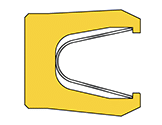
Standard seal height
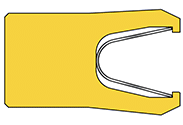
Extended seal height
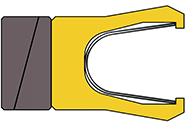
Example of back-up rings
• Gland Design and Installation…
• Gland Design and Installation
Gland Design and Installation
There are fundamentally three designs available:
- Split Housing Gland
- Step Gland
- Closed Gland
Consideration of proper gland geometry in the early stages of design can eliminate unnecessary installation problems.
Split Housing Gland (Separable):
The use of split or separable glands in piston and rod seal applications is recommended to eliminate the need to stretch or compress the seal during installation into the gland. Separable glands also can eliminate the need for special installation tools. This design can accommodate both, lips first or heel first seal installation.
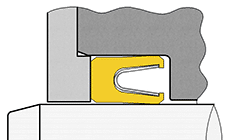
Split gland – rod sealing, lips first
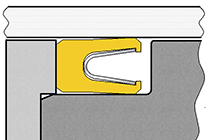
Split gland – piston sealing, lips first
Step Gland:
To minimize stretching or distortion during assembly in non-split glands, the gland side wall on the pressure side can be reduced to provide a partial shoulder to retain the seal. This gland design can only be used in a heel first installation. This is a preferred option if a split housing gland design cannot be accommodated.
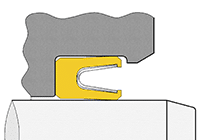
Step gland – rods sealing, heel first

Step gland – piston sealing, heel first
Closed Gland:
If stretching into a closed gland (full groove) is unavoidable, contact engineering for proper seal sizes, procedures and fitting tools.
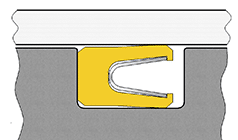
Closed gland – piston sealing

Closed gland – rod sealing
Assembly of the seal over sharp corners, threads, keyways, etc., must be avoided, or protective tooling should be used when these conditions exist.
• Symmetrical vs. non-symmetrical…
• Symmetrical vs. non-symmetrical
Symmetrical vs. Non-symmetrical
Symmetrical seals (PRS19 type) are centered in the gland and can be used as either rod seals or piston seals and may not perform as well as non-symmetrical rod seals or piston seals do because they are less stable during operating cycles. However an easier installation may require the use of a symmetrical design because of larger seal clearances.
Non-symmetrical seals offered by AHPSeals are specifically designed for dynamic rod (S19 type) or piston (K19 type) sealing applications. They are not centered in the gland groove and provide sealing contact with the gland across the entire surface of the static seal diameter for a more stable seal during cycling and better sealing performance than symmetrical seals.
AHPSeals utilizes a variety of standard and proprietary PTFE, Fluoropolymer compounds, proprietary Duraloy® materials, high-performance polymer materials, seal designs, spring types and seal lip configurations to meet the requirements of the most demanding sealing environments.
Our Spring energized PTFE Seals are classified as follows:
– VS-Series – V-Spring Seals
– SC-Series – Slanted Coil Spring Seals
– HS-Series – Helical Spring Seals
Application-specific and proprietary seal designs are available. Please contact engineering to get the best seal for your sealing applications.
VS-Series – V-Spring Seals
Typical Applications
Linear, reciprocating dynamic sealing applications, rotary sealing, abrasive media sealing with scraper seal lip design, applications where elastomeric seals fail to meet the temperature range, chemical resistance or friction requirements.
Operating Range
Pressure: up to 10,000psi (700bar)*. For pressure above 3,000psi (210bar), please contact engineering for clearances. Pressure ratings can be increased by reducing clearances.
Surface Speed: linear up to 33ft/s (10m/s)*, rotary up to 20ft/s (6m/s)* depending on seal
Temperature: -328°F to 500°F (-200°C to 260°C) depending on material
Materials: PTFE, filled PTFE, PCTFE, high-performance polyurethanes, NBR (Nitrile), FKM, Viton®, HNBR, low and high-temperature grades, FDA-compliant seal material grades and proprietary specialized Duralast™, Duraloy™, and Permachem™ compounds
Availability: More Info…
VS-Series – High Pressure & Special Designs
Application-specific and proprietary seal designs are available. Please contact engineering to get the best seal for your sealing applications.
SC-Series – Slanted Coil Spring Seals
Typical Applications
Linear, reciprocating dynamic sealing applications, for friction sensitive, low pressure sealing applications, small diameters <3/8” (9.5mm) and cross-sections
Operating Range
Pressure: up to 10,000psi (700bar)*. For pressure above 3,000psi (210bar), please contact engineering for clearances. Pressure ratings can be increased by reducing clearances.
Surface Speed: linear up to 33ft/s (10m/s)*, rotary up to 20ft/s (6m/s)* depending on seal type
Temperature: -328°F to 500°F (-200°C to 260°C) depending on material
Materials: PTFE, filled PTFE, PCTFE, high-performance polyurethanes, NBR (Nitrile), FKM, Viton®, HNBR, low and high-temperature grades, FDA-compliant seal material grades and proprietary specialized Duralast™, Duraloy™, and Permachem™ compounds
Availability: More Info…
Application-specific and proprietary seal designs including scraper lips are available. Please contact engineering to get the best seal for your sealing applications.
HS-Series – Helical Spring Seals
Typical Applications
Static rod and piston, static internal and external low- to high-pressure face seals, vacuum and cryogenic sealing, where sealing ability is most critical, highest sealing capability of spring-loaded seals under low pressure
Operating Range
Pressure: up to 10,000psi (700bar)*. For pressure above 3,000psi (210bar), please contact engineering for clearances. Pressure ratings can be increased by reducing clearances.
Surface Speed: up to 0.1 ft/s (0.3m/s)* intermittent
Temperature: -328°F to 500°F (-200°C to 260°C) depending on material
Materials: PTFE, filled PTFE, PCTFE, high-performance polyurethanes, NBR (Nitrile), FKM, Viton®, HNBR, low and high-temperature grades, FDA-compliant seal material grades and proprietary specialized Duralast™, Duraloy™, and Permachem™ compounds
Availability: More Info…
Application-specific and proprietary seal designs are available. Please contact engineering to get the best seal for your sealing applications.
Applications & Industries
AHP Seals’ Spring-energized PTFE Seals are suitable for service in the following industries:
- Pharmaceuticals
- Liquid Chromatography
- Food Processing
- Space Exploration
- Tire Production
- Hydraulics
- Vacuum Service
- Oilfield Exploration and Production
- Paint and Solvents
- Steel Mills
- Adhesives
- Cryogenic Service
- Liquid Handling Swivels
- Pumps and Valves
- Gas Production and Transportation
- Semiconductors
- Medical Equipment
- Gas Handling Equipment
*Maximum values depend on seal material, seal configuration, media, temperatures, pressures, surface speed, dynamic running surface finish and working environment. Data provided are guidelines for ideal operating conditions. Seals cannot be operated at their upper pressure and speed ratings at the same time. For maximum seal life expectancy, do not operate your seal beyond 75% of any of its operating limits. Please consult engineering or call 1-800-283-7140 for advice.
American High Performance Seals assumes no obligation or liability for any advice furnished or results obtained with respect to these products. All such advice is given and accepted at the buyer’s risk. This information, based on our experience, is offered as part of our service to customers. It is intended for use by persons having technical skill, at their own discretion and risk. We do not guarantee favorable results, and we assume no liability in connection with its use.
Any purchases resulting from information provided by American High Performance Seals, Inc., including proposals, recommendations and quotes, are subject to “AHPSEALS TERMS AND CONDITIONS OF SALE.”
